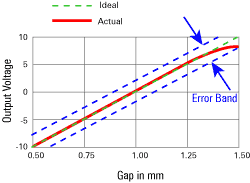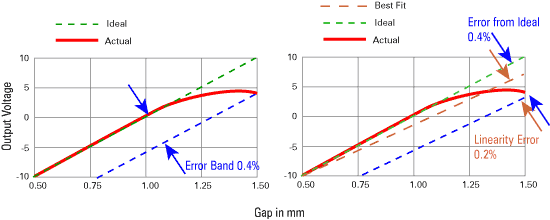Error Band (more meaningful than Linearity)

Error band is a measurement of worst case error. This is the best specification (compared to linearity) to determine gauge suitability for an application.
The Error Band specification describes a bipolar band (i.e. ±0.2%) around the ideal line. The “ideal line” is the line plotted where all dimensional changes produce perfect sensor output voltages. All measurements must fall within the Error Band for the instrument to be within specification. The magnitude of the band is equal to the worst case error throughout the gauge’s measurement range. Using the worst case error assures that every measurement made by the gage will perform within the Error Band specification.
Linearity can be Deceiving
Gauges could be very linear but completely inaccurate if the “line” is not equal to the ideal line. A gauge’s Linearity performance is always better than its Error Band performance. Linearity specifications describe a band around the BEST FIT line into which all measurements must fall. But the best fit line is a different line than the ideal line. This means that the gage may have a linearity specification of 0.2% but still produce measurements that are inaccurate by 0.4%.
The plots below are exaggerated to show detail. The same data is plotted for Error Band on the left, then plotted on the right for Linearity against the best fit line. Because the best fit line deviates from the ideal line, the Linearity error is half of the Error Band.

